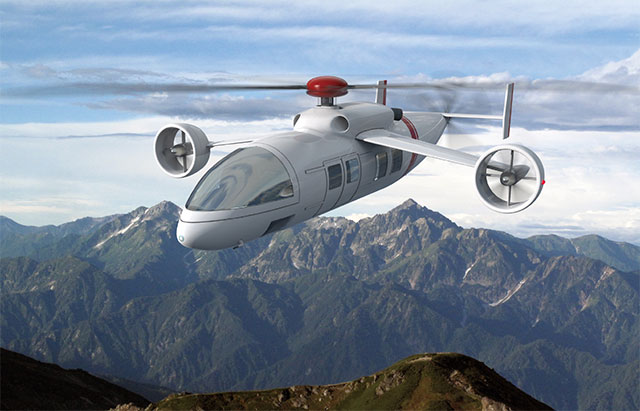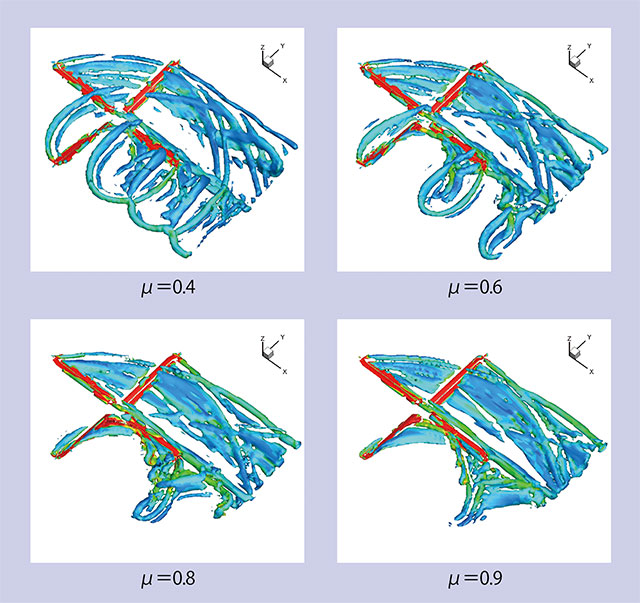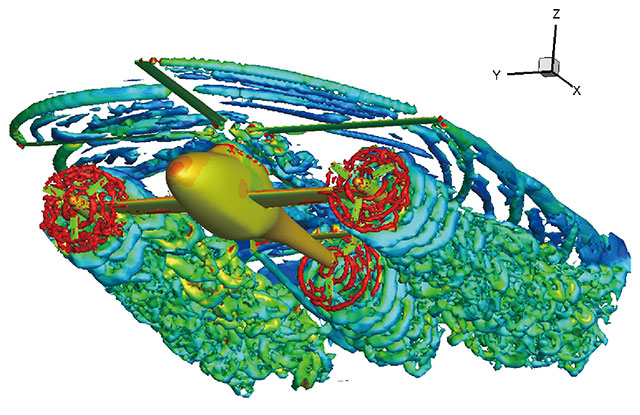About us
JAXA Aviation helps to create a safer and more prosperous society with aeronautics-related research and development activities.
FLIGHT PATH No.24 | 2019 WINTER
<Aeronautics in depth>
High-speed rotary-wing aircraft
Helicopters (rotary-wing aircraft) are widely used as air ambulances and in disaster relief operations, as they can take off and land vertically and hover in the air. However, there is room for improvement in cruising speed to enable more prompt emergency medical services (EMS). JAXA is therefore working to research and develop a new concept of high-speed compound helicopters and related key technologies.
Next-generation high-speed helicopters to aim for top speed of 500 km/h
Many countries are pursuing research and development of next-generation high-speed helicopters. These helicopters aim to achieve top speeds of around 500 km/h, which is roughly twice as fast as conventional helicopters. Once achieved, the area that can be reached by an air ambulance within 15 minutes will expand to cover virtually the entire territory of Japan from current existing base hospitals. When conventional helicopters fly at high speeds, drag increases considerably on the advancing side of the rotor, while airspeed decreases on the retreating side, losing lift.* To solve this structural problem, high-speed rotary-wing aircraft such as tilt-rotor aircraft (which change the tilt angle of the rotors during flight) were developed, but their mechanism is extremely complicated, posing maintenance and other operational issues. Therefore, JAXA has proposed a compound system as an alternative concept for faster helicopters of future generations and is carrying out researches on the key technologies.
* The advancing side is the side of blades that moves toward the direction of flight, and the retreating side is the side that moves away from the direction of flight.
JAXA’s proposal of a next-generation high-speed compound helicopter

A concept of a high-speed compound helicopter proposed by JAXA
The high-speed compound helicopter proposed has a fixed wing in addition to a main rotor to generate weight-supporting lift forces. It flies forward with the thrust forces mainly generated by an aft-mounted propeller. The main rotor and aft-mounted propeller are driven by an engine, while electrically-driven antitorque fans (for preventing the rotor from causing the fuselage to rotate) are mounted at both ends of a main wing like that of a fixed-wing aircraft. Since the electric fans operate mechanically independently of the main rotor, the structure is simple, enabling weight reduction.
The proposed compound helicopter concept does not have a mechanical transition mode from hovering to high-speed flight, which is considered safer than the tilt-rotor system, which requires subtle speed adjustments according to the tilt angle of the rotors during the transition from vertical to horizontal flight.

Schematic diagrams of a high-mu rotor blade with an optimized shape, featuring a curvilinear form with broad tips, whereas conventional rotors generally have a linear form with thin, long blades (patent pending).
Development of efficient wing placement and rotor blade
One issue that needs to be addressed in a compound system is the aerodynamic interference between the rotor and main wing. Unlike conventional helicopters, which fly forward by tilting the fuselage and rotor forward, compound helicopters fly in a nearly horizontal attitude like a fixed-wing aircraft. When the aerodynamic interference between the rotor and the main wing increases, propulsion efficiency decreases, so the rotor and main wing have to be arranged in the optimal manner to minimize interference. Moreover, when the airspeed of the blade approaches the speed of sound, compressed air around the blades start forming shock waves, rapidly increasing aerodynamic drag on the rotor blades. To keep the advancing side of the rotor from approaching the speed of sound, the main rotor speed is decreased by about 20% so that the reverse flow region increases on the retreating side of the rotor. This requires a specifically designed rotor (high-mu rotor, for short) suitable for flight at a high advance ratio (the ratio of the advancing speed to the rotor-blade tip speed is called advance ratio μ) that will be quite different from that of conventional helicopters. JAXA is developing an optimal high-mu rotor with a completely new blade shape, capable of both high hovering performance and advancing performance required for high-speed flight, using a computational fluid dynamics (CFD) analysis tool to analyze the vast number of parameters. Development of this new main rotor shape is one of key component technologies essential to high-speed flight.

A visual representation of the relationship between the rotor’s advance ratio and flow field, examined by CFD analysis. The flow on the advancing side and retreating side changes with the value of the advance ratio (μ), and this significantly affects the rotor’s flight efficiency.
JAXA is also working to find the optimal fuselage shape and component layout by performing CFD analysis of the complex flow around the helicopter fuselage. By using 3D visualization technology, the state of airflow interference can be observed in three dimensions.
Based on these studies, JAXA has conducted flight tests, as well as wind tunnel tests, using a scale model. In November 2019, a wind tunnel test has also been conducted on an improved version of the model that incorporated new ideas like a large flap mechanism for reducing the interference of the main rotor and main wing during hovering maneuvers.

3D visualization of the airflow around a compound helicopter with four rotors, based on CFD analysis